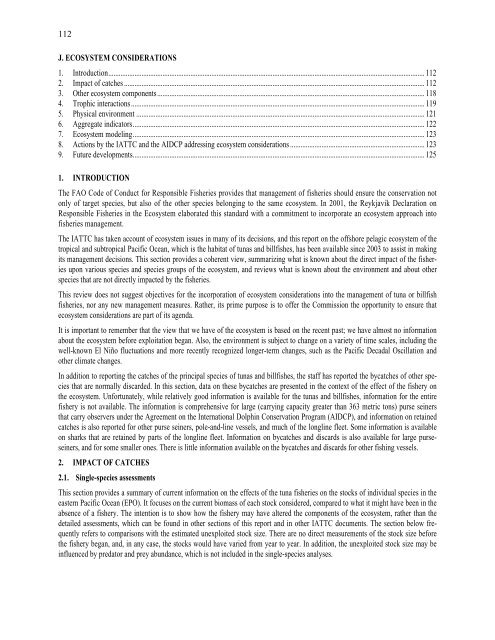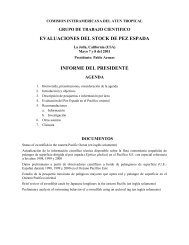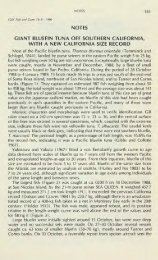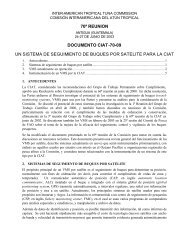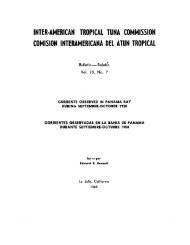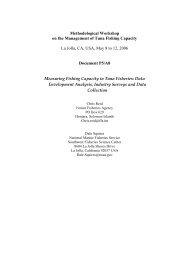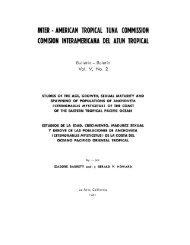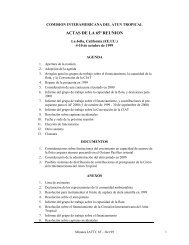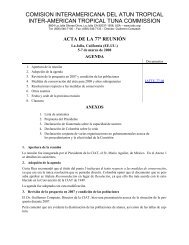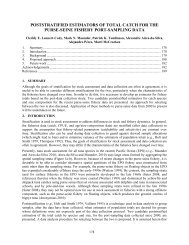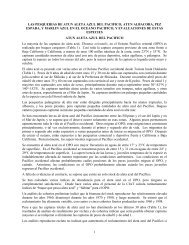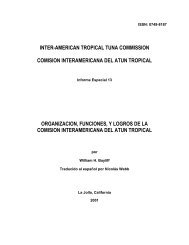INTER-AMERICAN TROPICAL TUNA COMMISSION - Comisión ...
INTER-AMERICAN TROPICAL TUNA COMMISSION - Comisión ...
INTER-AMERICAN TROPICAL TUNA COMMISSION - Comisión ...
- No tags were found...
Create successful ePaper yourself
Turn your PDF publications into a flip-book with our unique Google optimized e-Paper software.
112J. ECOSYSTEM CONSIDERATIONS1. Introduction..................................................................................................................................................................................... 1122. Impact of catches ............................................................................................................................................................................ 1123. Other ecosystem components......................................................................................................................................................... 1184. Trophic interactions........................................................................................................................................................................ 1195. Physical environment ..................................................................................................................................................................... 1216. Aggregate indicators....................................................................................................................................................................... 1227. Ecosystem modeling....................................................................................................................................................................... 1238. Actions by the IATTC and the AIDCP addressing ecosystem considerations ............................................................................. 1239. Future developments....................................................................................................................................................................... 1251. INTRODUCTIONThe FAO Code of Conduct for Responsible Fisheries provides that management of fisheries should ensure the conservation notonly of target species, but also of the other species belonging to the same ecosystem. In 2001, the Reykjavik Declaration onResponsible Fisheries in the Ecosystem elaborated this standard with a commitment to incorporate an ecosystem approach intofisheries management.The IATTC has taken account of ecosystem issues in many of its decisions, and this report on the offshore pelagic ecosystem of thetropical and subtropical Pacific Ocean, which is the habitat of tunas and billfishes, has been available since 2003 to assist in makingits management decisions. This section provides a coherent view, summarizing what is known about the direct impact of the fisheriesupon various species and species groups of the ecosystem, and reviews what is known about the environment and about otherspecies that are not directly impacted by the fisheries.This review does not suggest objectives for the incorporation of ecosystem considerations into the management of tuna or billfishfisheries, nor any new management measures. Rather, its prime purpose is to offer the Commission the opportunity to ensure thatecosystem considerations are part of its agenda.It is important to remember that the view that we have of the ecosystem is based on the recent past; we have almost no informationabout the ecosystem before exploitation began. Also, the environment is subject to change on a variety of time scales, including thewell-known El Niño fluctuations and more recently recognized longer-term changes, such as the Pacific Decadal Oscillation andother climate changes.In addition to reporting the catches of the principal species of tunas and billfishes, the staff has reported the bycatches of other speciesthat are normally discarded. In this section, data on these bycatches are presented in the context of the effect of the fishery onthe ecosystem. Unfortunately, while relatively good information is available for the tunas and billfishes, information for the entirefishery is not available. The information is comprehensive for large (carrying capacity greater than 363 metric tons) purse seinersthat carry observers under the Agreement on the International Dolphin Conservation Program (AIDCP), and information on retainedcatches is also reported for other purse seiners, pole-and-line vessels, and much of the longline fleet. Some information is availableon sharks that are retained by parts of the longline fleet. Information on bycatches and discards is also available for large purseseiners,and for some smaller ones. There is little information available on the bycatches and discards for other fishing vessels.2. IMPACT OF CATCHES2.1. Single-species assessmentsThis section provides a summary of current information on the effects of the tuna fisheries on the stocks of individual species in theeastern Pacific Ocean (EPO). It focuses on the current biomass of each stock considered, compared to what it might have been in theabsence of a fishery. The intention is to show how the fishery may have altered the components of the ecosystem, rather than thedetailed assessments, which can be found in other sections of this report and in other IATTC documents. The section below frequentlyrefers to comparisons with the estimated unexploited stock size. There are no direct measurements of the stock size beforethe fishery began, and, in any case, the stocks would have varied from year to year. In addition, the unexploited stock size may beinfluenced by predator and prey abundance, which is not included in the single-species analyses.


